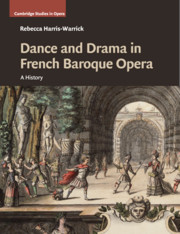Book contents
- Dance and Drama in French Baroque Opera
- Cambridge Studies in Opera
- Dance and Drama in French Baroque Opera
- Copyright page
- Dedication
- Contents
- Figures
- Acknowledgements
- Notes to the text
- Abbreviations
- Introduction
- Part I Lully
- Part II The Rival Muses in the Age of Campra
- Epilogue
- Book part
- Bibliography
- Index of People and Terms
- Index of Works
- References
Bibliography
Published online by Cambridge University Press: 03 November 2016
- Dance and Drama in French Baroque Opera
- Cambridge Studies in Opera
- Dance and Drama in French Baroque Opera
- Copyright page
- Dedication
- Contents
- Figures
- Acknowledgements
- Notes to the text
- Abbreviations
- Introduction
- Part I Lully
- Part II The Rival Muses in the Age of Campra
- Epilogue
- Book part
- Bibliography
- Index of People and Terms
- Index of Works
- References
- Type
- Chapter
- Information
- Dance and Drama in French Baroque OperaA History, pp. 457 - 471Publisher: Cambridge University PressPrint publication year: 2016



